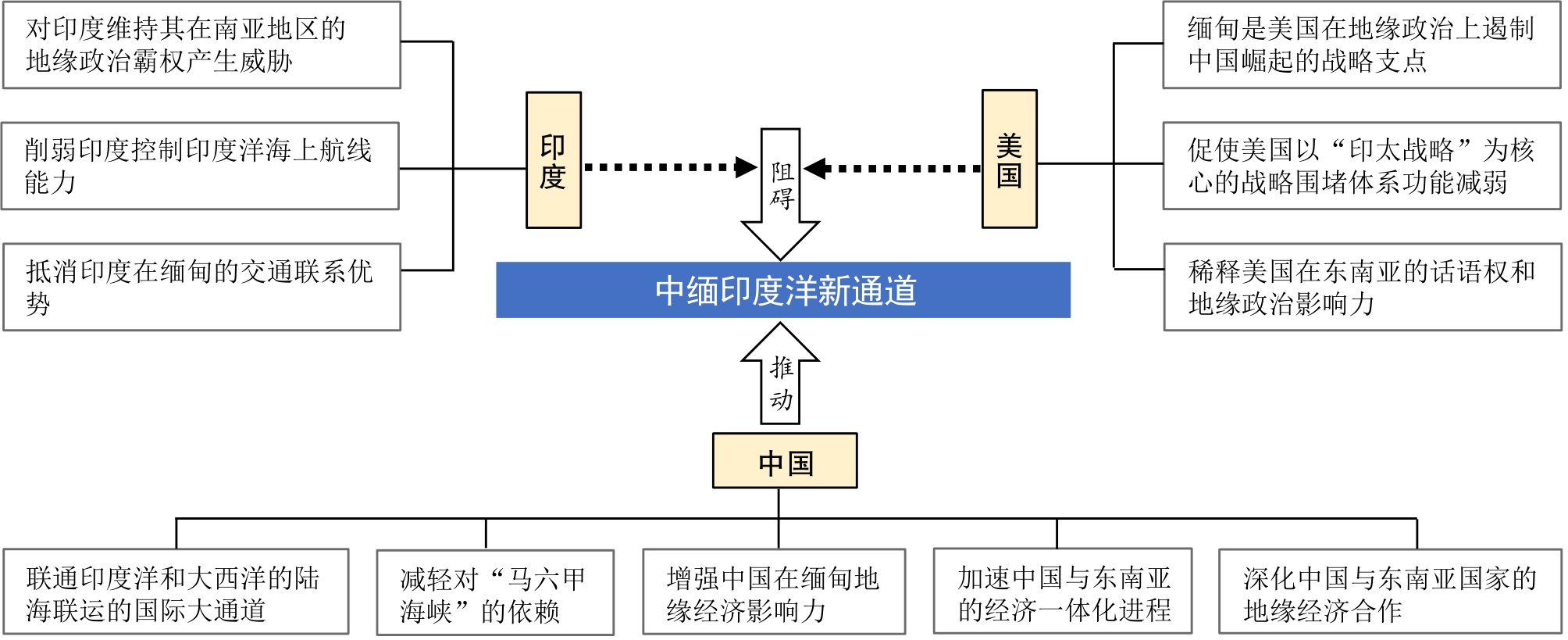

中缅印度洋新通道的地缘经济合作障碍及其协作机制
|
胡伟(1990—),男,湖北黄冈人,博士,副教授,研究方向为全球化与地缘环境,(E-mail)huweilt1990@163.com。 |
收稿日期: 2023-10-24
修回日期: 2024-03-27
网络出版日期: 2024-07-05
基金资助
国家自然科学基金项目(42201258)
教育部人文社会科学研究青年基金项目(22YJCZH057)
国家社会科学基金重大项目(20&ZD138)
Obstacles to Geo-Economic Cooperation in the China-Myanmar Indian Ocean New Channel and Its Collaborative Mechanisms
Received date: 2023-10-24
Revised date: 2024-03-27
Online published: 2024-07-05
中缅印度洋新通道是推进中缅地缘经济合作和“一带一路”建设的重要载体,解析中缅印度洋新通道的地缘经济合作障碍及其协作机制,将为提升中缅印度洋新通道的地缘经济效应和加强中缅地缘经济合作提供重要的科技支撑。中缅印度洋新通道的地缘经济合作障碍不仅有地理环境的阻碍,更有中缅经济发展差异、复杂武装冲突干扰、大国干预掣肘和多元利益主体博弈的地缘风险的束缚。中缅印度洋新通道的地缘经济合作并不是一种区域控制战略工具,而是打造一条交通物流、供应链、产业链、价值链深度关联的国际贸易走廊。为了推进中缅印度洋新通道的地缘经济合作,中缅印度洋新通道建设应构建多层次的地缘经济合作协作机制。在国家层面,应通过推动中缅印度洋新通道与“一带一路”倡议的融合、强化中缅政策沟通机制对接、制定中缅印度洋新通道长远发展战略规划来加强中缅发展战略对接。在通道层面,应通过推动内外部基础设施联动、强化跨境地缘经济要素流动和产业协作、深化面向缅甸及印度洋地区的经贸合作来升级中缅印度洋新通道地缘经济效应。在利益主体层面,应通过强化多方利益对接、统筹中缅口岸协调对接机制、创建立体化新通道风险防范机制来构建多元利益主体参与的协商机制。

胡伟 , 方祥云 , 叶程溥 , 胡志丁 , 李灿松 . 中缅印度洋新通道的地缘经济合作障碍及其协作机制[J]. 热带地理, 2024 , 44(7) : 1161 -1170 . DOI: 10.13284/j.cnki.rddl.20230811
In the era of globalized geo-economics, international big channel are changing the way geo-economic elements flow across borders, expanding cooperation spaces such as ports and border-free trade zones to more distant inland areas and shaping new ways of cross-border geo-economic cooperation. As an international land and sea channel connecting China and Myanmar, the China-Myanmar Indian Ocean New Channel (hereinafter "the Channel") is of great importance for promoting geo-economic cooperation between the two countries and the construction of the Belt and Road Initiative. However, owing to various obstacles in geo-economic cooperation, the geo-economic effect of the Channel has not been effectively brought into play. In this study, the obstacles to geo-economic cooperation in the Channel and its collaborative mechanisms were analyzed to provide important scientific and technological support for enhancing its geo-economic effects and strengthening geo-economic cooperation between China and Myanmar. The natural geography of the region with its high mountains and deep valleys and the frequently occurring natural disasters are natural obstacles that limit the geo-economic effect of the Channel. Moreover, the difference in economic development between China and Myanmar is not conducive to the deepening of geo-economic cooperation in the Channel. Complex armed conflicts have disrupted the construction of the Channel and China's investment in its route, and the potential intervention of India and the United States will become an added constraint on its further development. Furthermore, the multiple stakeholders game in the construction of the Channel may bring geo-risks. Contrary to preconceived notions, geo-economic cooperation in the Channel is not a strategy for regional control, but rather to create an international trade corridor deeply related to transportation logistics, supply chains, industrial chains and value chains. To promote geo-economic cooperation in the Channel, its construction should be based on a multi-level collaborative mechanism for geo-economic cooperation. At the national level, the docking of development strategies between China and Myanmar should be strengthened by promoting integration of the Channel into the Belt and Road Initiative, strengthening the docking of China-Myanmar policy communication mechanisms, and formulating a long-term development strategy plan for the Channel. At the channel level, the geo-economic effect of the Channel should be upgraded by promoting the linkage of internal and external infrastructures, strengthening geo-economic element cross-border flow and industrial cooperation, and deepening economic and trade cooperation with Myanmar and the Indian Ocean region. At the stakeholder level, a consultation mechanism involving multi-stakeholder participation should be established by strengthening the docking of multi-stakeholder interests, coordinating the mechanism of China-Myanmar port docking, and creating a three-dimensional risk prevention mechanism for the Channel.


1 https://swt.yn.gov.cn/articles/44666
2 https://www.gscloud.cn/
3 https://acleddata.com/
4 https://www.shihang.org/zh/home
胡 伟:论文构思,论文设计,论文拟写和修改;
方祥云:文献整理,图表绘制;
叶程溥:数据收集,论文修改;
胡志丁:指导论文设计和论文修改;
李灿松:指导论文构思,参与论文修改。
|
陈继东. 1998. 中国―缅甸―印度陆上贸易通道建设初探. 南亚研究季刊,(2):5-14.
Chen Jidong. 1998. Anintial Study of Building of a Land Passage of Trade From China Via Burma to India. South Asian Studies Quarterly, (2): 5-14.
|
|
Dwyer M B. 2020. "They Will not Automatically Benefit": The Politics of Infrastructure Development in Laos's Northern Economic Corridor. Political Geography, 78: 102118.
|
|
胡志丁,骆华松,李灿松,付磊,熊理然. 2015. 2009年后缅甸国内冲突的地缘政治学视角解读. 热带地理,35(4):561-568.
Hu Zhiding, Luo Huasong, Li Cansong, Fu Lei, and Xiong Liran. 2015. Interpretation of the Conflict in Myanmar from Geopolitical Perspective after 2009. Tropical Geography, 35(4): 561-568.
|
|
胡平平,武友德,李灿松,王敏. 2023. 缅北武装冲突的时空演变及对中国西南边疆地区的影响. 世界地理研究,32(7):75-87.
Hu Pingping, Wu Youde, Li Cansong, and Wang Min. 2023. Spatio-Temporal Evolution of the Armed Conflict in Northern Myanmar and its Impact on China's Southwestern Border Area. World Regional Studies, 32(7): 75-87.
|
|
蒋龙侠. 2021. 新时代影响中缅关系发展的变量研究. 公关世界,(2):84-85.
Jiang Longxia. 2021. A Study of the Variables Affecting the Development of China-Myanmar Relations in the New Era. PR World, (2): 84-85.
|
|
李晨阳. 2012. 2010年大选之后的中缅关系:挑战与前景. 和平与发展,(2):29-37.
Li Chenyang. 2012. Myanmar's Relationship with China After Its 2010 General Elections: Its Challenges and Prospects. Peace and Development, (2): 29-37.
|
|
李灿松,胡平平,杨旺舟. 2019. 缅北局势及其对中缅经济走廊建设的影响. 热带地理,39(6):823-832.
Li Cansong, Hu Pingping, and Yang Wangzhou. 2019. Impact of the Northern Myanmar Situation on the China-Myanmar Economic Corridor Construction. Tropical Geography, 39(6): 823-832.
|
|
李逸,赵媛,夏四友. 2024. 中国跨境油气运输管道安全性评价与类型区划分. 自然资源学报,39(3):547-563.
Li Yi, Zhao Yuan, and Xia Siyou. 2024. Safety Evaluation and Classification of Cross-Border Oil and Gas Transportation Pipelines in China. Journal of Natural Resources, 39(3): 547-563.
|
|
陆大道. 1988. 区位论及区域研究方法. 北京:科学出版社.
Lu Dadao. 1988. Locality Theory and Regional Research Methodology. Beijing: Science Press.
|
|
刘卫东. 2015. “一带一路”战略的科学内涵与科学问题. 地理科学进展,34(5):538-544.
Liu Weidong. 2015. Scientific Understanding of the Belt and Road Initiative of China and Related Research Themes. Progress in Geography, 34(5): 538-544.
|
|
Morgenthau H J. 1967. Politics Among Nations: The Struggle for Power and Peace. New York: Alfred A. Knopf.
|
|
Mostafanezhad M, Sebro T, Prasse-Freeman E, and Norum R. 2022. Surplus Precaritization: Supply Chain Capitalism and the Geoeconomics of Hope in Myanmar's Border Lands. Political Geography, 95: 102561.
|
|
马腾,葛岳静,黄宇,胡志丁. 2017 . 微观尺度下边境口岸对载体城市的影响及其机制研究——以德宏州中缅边境口岸为例. 热带地理,37(2):185-192.
Ma Teng, Ge Yuejing, Huang Yu, and Hu Zhiding. 2017. Influential Factors and Effects of Border Ports on Carrier Cities at Micro-Scale: A Case Study of Sino-Myanmar Border Ports in Dehong Prefecture. Tropical Geography, 37(2): 185-192.
|
|
全毅. 2021. 西部陆海通道建设与西南开放开发新思路. 经济体制改革,(2):50-55.
Quan Yi. 2021. Construction of the New Western Land-Sea Corridor and New Ideas of Opening and Development of Southwest China. Reform of Economic System, (2): 50-55.
|
|
钱林,黄伟新. 2022. 中国西部地区合作参建西部陆海新通道的现状及问题. 物流科技,45(19):97-102.
Qian Lin and Huang Weixin. 2022. Current Situation and Problems of Western China's Cooperative Participation in the Construction of a New Western Land-Sea Corridor. Logistics Sci-Tech, 45(19): 97-102.
|
|
Su X and Lim K F. 2019. Opium Substitution, Reciprocal Control and the Tensions of Geoeconomic Integration in the China-Myanmar Border. Environment and Planning A: Economy and Space, 51(8): 1665-1683.
|
|
宋涛 2016. 中国对缅甸直接投资的发展特征及趋势研究. 世界地理研究,25(4):40-47.
Song Tao. 2016. Research on the Current Situation and Trends of China's Direct Investment in Myanmar. World Regional Studies, 25(4): 40-47.
|
|
宋大伟,赵璐,沈熙,张凤,王光辉,刘昌新,朱永彬 . 2022. 中缅印度洋新通道建设战略研究――运用智库双螺旋法谋划海公铁跨境多式联运. 中国科学院院刊,37(11):1595-1601.
Song Dawei, Zhao Lu, Shen Xi, Zhang Feng, Wang Guanghui, Liu Changxin, and Zhu Yongbin. 2022. Research on the Strategy of China-Myanmar-Indian Ocean New Channel: Application of Double Helix Methodology in Think Tanks to Planning Cross-Border Multimodal Transportation of Ocean Shipping, Highway and Railway. Bulletin of Chinese Academy of Sciences, 37(11): 1595-1601.
|
|
孙灿. 2022. 理解跨国经济走廊:一项研究议程. 国外社会科学前沿,(10):88-99.
Sun Can. 2022. Understanding Transnational Economic Corridors: A Research Agenda. Journal of International Social Sciences, (10): 88-99.
|
|
王志民. 2014. 西南周边地缘态势与“南方丝绸之路”新战略. 东北亚论坛,23(1):94-105.
Wang Zhiming. 2014. Southwest Geopolitical Situation and the "Southern Silk Road" New Strategy. Northeast Asia Forum, 23(1): 94-105.
|
|
王颖. 2021. 印度“印太”认知及其对“21世纪海上丝绸之路”的影响. 南亚研究季刊,(3):17-31.
Wang Yin. 2021. India's Indo-Pacific Strategic Cognition and Its Impact on the Construction of the Maritime Silk Road of the 21st Century. South Asian Studies Quarterly, (3): 17-31.
|
|
吴良,秦奇,张丹,成升魁. 2018. 印度洋通道及其对中国地缘环境影响. 地理科学进展,37(11):1510-1520.
Wu Liang, Qin Qi, Zhang Dan, and Cheng Shengkui. 2018. Indian Ocean Passages and Their Geopolitical Impacts on China. Progress in Geographic Science, 37(11): 1510-1520.
|
|
尹响,赵师苇. 2020. 孟中印缅经济走廊视域下中缅经济走廊建设的机遇、挑战与对策. 南亚研究季刊,(4):33-43.
Yin Ring and Zhao Shiwei. 2020. Opportunities, Challenges and Solutions of China-Myanmar Economic Corridor Construction from the Perspective of BCIM. South Asian Studies Quarterly, (4): 33-43.
|
|
朱立. 2014. 经济政治化:中国投资在缅甸的困境与前景. 印度洋经济体研究,(3):33-46.
Zhu Li. 2014. Politicization of Economic Behavior: Difficulties and Prospects of China's Investment in Myanmar. Indian Ocean Economic and Political Review, (3): 33-46.
|
|
张喆,胡志丁. 2024. 拼装视角下中缅印度洋新通道建设的地理过程. 地理学报,79(6):1556-1572. [Zhang zhe, Hu Zhiding. 2024. The Geographical Process of International Corridor Construction:The Assemblage Perspective of China-Myanmar Indian Ocean New Channel. Acta Geographica Sinica, 79(6): 1556-1572.
|
/
| 〈 |
|
〉 |